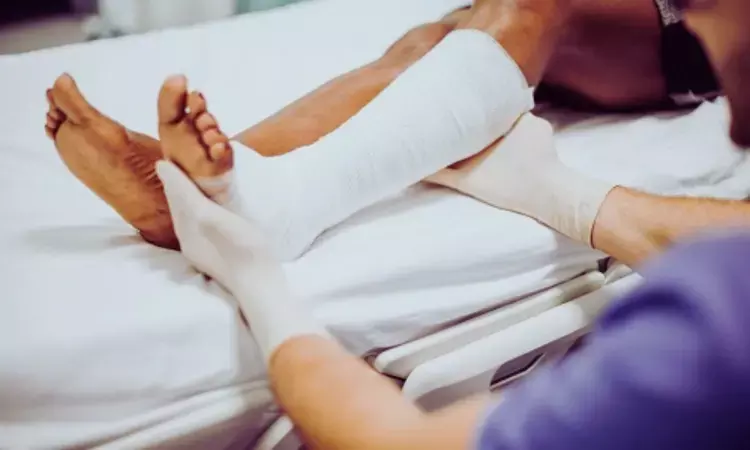- Home
- Medical news & Guidelines
- Anesthesiology
- Cardiology and CTVS
- Critical Care
- Dentistry
- Dermatology
- Diabetes and Endocrinology
- ENT
- Gastroenterology
- Medicine
- Nephrology
- Neurology
- Obstretics-Gynaecology
- Oncology
- Ophthalmology
- Orthopaedics
- Pediatrics-Neonatology
- Psychiatry
- Pulmonology
- Radiology
- Surgery
- Urology
- Laboratory Medicine
- Diet
- Nursing
- Paramedical
- Physiotherapy
- Health news
- Fact Check
- Bone Health Fact Check
- Brain Health Fact Check
- Cancer Related Fact Check
- Child Care Fact Check
- Dental and oral health fact check
- Diabetes and metabolic health fact check
- Diet and Nutrition Fact Check
- Eye and ENT Care Fact Check
- Fitness fact check
- Gut health fact check
- Heart health fact check
- Kidney health fact check
- Medical education fact check
- Men's health fact check
- Respiratory fact check
- Skin and hair care fact check
- Vaccine and Immunization fact check
- Women's health fact check
- AYUSH
- State News
- Andaman and Nicobar Islands
- Andhra Pradesh
- Arunachal Pradesh
- Assam
- Bihar
- Chandigarh
- Chattisgarh
- Dadra and Nagar Haveli
- Daman and Diu
- Delhi
- Goa
- Gujarat
- Haryana
- Himachal Pradesh
- Jammu & Kashmir
- Jharkhand
- Karnataka
- Kerala
- Ladakh
- Lakshadweep
- Madhya Pradesh
- Maharashtra
- Manipur
- Meghalaya
- Mizoram
- Nagaland
- Odisha
- Puducherry
- Punjab
- Rajasthan
- Sikkim
- Tamil Nadu
- Telangana
- Tripura
- Uttar Pradesh
- Uttrakhand
- West Bengal
- Medical Education
- Industry
Indian Orthopedics: New Study Traces Its Evolution From Ancient Traditions to Global Leadership

India: A new article published in Annals of the National Academy of Medical Sciences (India) highlights the remarkable journey of Indian orthopedics—from its ancient foundations to its current standing as a global leader in surgical innovation and research.
Authored by Dr. Raju Vaishya and Dr. Abhishek Vaish from Indraprastha Apollo Hospitals, New Delhi, the paper offers a sweeping historical perspective, highlighting how centuries of indigenous knowledge and modern scientific progress have shaped the specialty.
The study traces the origins of orthopedic practice in India to the Indus Valley Civilization, where early forms of fracture care were already evident. Ancient texts, especially those from the Ayurvedic tradition, provided detailed descriptions of bone-setting and prosthetic techniques long before the advent of modern medical science. Reflecting on these deep-rooted beginnings, Dr. Raju Vaishya noted, “Indian orthopaedics has an ancient and profound history, dating back to the Indus Valley Civilisation (around 3300 BC), with evidence of early bone-setting. This legacy continued with Ayurveda and pioneers like Susruta, the ‘Father of Indian Surgery’, whose text, the Susruta Samhita, described techniques like bone setting and rudimentary prosthetics.”
The authors explain that the 20th century marked a transformative era, shifting the discipline from traditional practice to a structured, academic specialty. Visionaries such as Prof. B.N. Sinha, who established India’s first independent Orthopedic Surgery Department in 1951, played a pivotal role in building institutional frameworks. Elaborating on these milestones, Dr. Abhishek Vaish said, “The 20th century marked a paradigm shift, driven by pioneers such as Prof. B. N. Sinha… This era also saw the establishment of the Indian Orthopaedic Association in 1955, which is now the world’s most prominent national organisation for orthopaedic surgeons with over 15,000 members. Key innovations like Dr. P. K. Sethi’s ‘Jaipur Foot’ also provided world-renowned, cost-effective mobility solutions.”
The article highlights rapid growth in India’s orthopedic research output, particularly over the past three decades. Publications in orthopedics and sports medicine have increased exponentially—from 22 papers in 1996 to 1,167 in 2024, improving India’s global ranking from 31st to 14th. According to the authors, this momentum is closely tied to the adoption of advanced surgical technologies, including navigation systems, robotic platforms, and minimally invasive techniques. As Dr. Raju Vaishya emphasized, “Indian orthopaedics is a thriving 21st-century field… This scientific surge has improved India’s global ranking, establishing it as a key global and Asian player.”
In his concluding message, Prof. Raju Vaishya noted that the specialty is entering a “moment of unprecedented acceleration.” He added, “We’re not just practising medicine; we’re embracing minimally invasive surgery, robotics, and advanced research… The future promises even greater heights of excellence, and our work is key to ensuring exceptional care for generations to come.”
"By weaving together ancient wisdom and cutting-edge innovation, the article positions Indian orthopedics as a field deeply rooted in history yet firmly oriented toward the future," the study authors wrote.
Reference:
Vaishya R, Vaish A. Evolution of Indian orthopedics and the legacy of its pioneers. Ann Natl Acad Med Sci (India). doi: 10.25259/ANAMS_29_2025
Dr Kamal Kant Kohli-MBBS, DTCD- a chest specialist with more than 30 years of practice and a flair for writing clinical articles, Dr Kamal Kant Kohli joined Medical Dialogues as a Chief Editor of Medical News. Besides writing articles, as an editor, he proofreads and verifies all the medical content published on Medical Dialogues including those coming from journals, studies,medical conferences,guidelines etc. Email: drkohli@medicaldialogues.in. Contact no. 011-43720751


